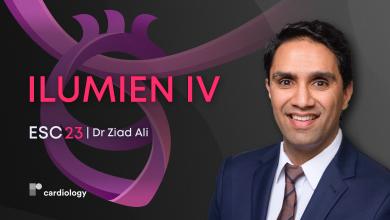Search results
AF, Stent and Anticoagulant
Author(s):
Balen Abdulrahman
,
Richard J Jabbour
,
Nick Curzen
Added:
10 months ago
Article
Author(s):
Ziad A Ali
Added:
7 months ago
ESC 2023 — Dr Ziad Ali (DeMatteis St Francis, US) joins us to discuss the findings from the ILUMIEN IV clinical trial (NCT03507777).
ILUMIEN IV (Abbott Medical Devices)is a prospective, single-blind clinical trial aiming to compare optical coherence tomography (OCT) to an angiography-guided stent implantation strategy. The trial investigated which method achieved a larger post-percutaneous…
View more
Platelet Function Testing in Clinical Practice - Experience and Views from Europe and the US
Author(s):
Thomas O Bergmeijer
,
Jochem Wouter van Werkum
,
Udaya S Tantry
,
et al
Added:
3 years ago
Article
Author(s):
Kamal Chitkara
,
Anthony H Gershlick
Added:
3 years ago
First-generation Stents
Since drug-eluting stents (DES) received the CE mark in 2002 and the US Food and Drug Administration (FDA) approved the first DES in 2003, there has been a significant increase in the use of these devices. The advent of DES has revolutionised the field of interventional cardiology by having a major impact on patient care through their efficacy in reducing the need for…
View more
Author(s):
Tom Adriaenssens
,
Giovanni J Ughi
,
Jan Dhooge
,
et al
Added:
3 years ago
In the bare metal stent (BMS) era, several intravascular ultrasound(IVUS) studies have validated the strategy of reducing in-stent restenosis rates by a strict adherence to an optimal stent implantation technique, predominantly by avoiding stent underexpansion.1 In a first phase after the introduction of drug-eluting stents(2003), the spectacular reduction in restenosis rates, based on…
View more
Author(s):
Colin T Phillips
,
Michael C Gavin
Added:
3 years ago
Acute coronary syndrome (ACS) occurs most often when a vulnerable intracoronary plaque ruptures or erodes to expose a prothrombotic core, precipitating thrombus formation by way of platelet activation,1–3 The spectrum of ACS includes non-ST segment-elevation (NSTE) ACS, where a vulnerable plaque threatens downstream coronary perfusion manifest as an increase in symptom frequency and/or duration …
View more
Author(s):
Francesco Prati
,
Fabrizio Imola
Added:
3 years ago
Many experts would agree that the concept of looking at vessel architecture from the inside using intracoronary probes, instead of simply relying on the angiographic vessel cast, is an elegant way to practise interventional cardiology in order to decide whether to treat a coronary artery and to guide coronary intervention. The historical development of stents neatly exemplifies this notion: the…
View more
Added:
3 years ago
Results from LEADERS FREE sub-study in acute coronary syndromes report for the first time
Paris, France 17 May 2016: Patients with acute coronary syndromes (ACS) who are at high risk for bleeding have significantly lower rates of target lesion revascularisation and fewer adverse events after undergoing percutaneous coronary intervention (PCI) with a polymer-free biolimus-A (BA9) drug-coated…
View more
Author(s):
Kalpa De Silva
Added:
1 year ago
Author(s):
Didier Carrie
Added:
3 years ago
According to the International Diabetes Federation, 382 million people had diabetes in 2013, with diabetes mellitus (DM) accounting for around 90 % of all diabetes cases. By 2025 the number will rise to 592 million.1 The association between DM and cardiovascular disease is well established2 and percutaneous coronary intervention (PCI) is associated with worse clinical and angiographic outcomes…
View more













 « First
« First